
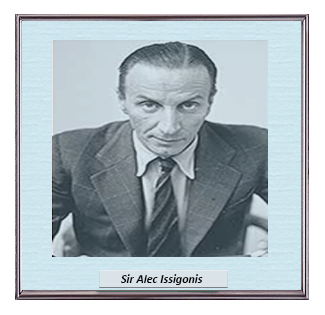 First launched in 1959, the Mini was not officially classed as a brand in its own right till the late Sixties.
First launched in 1959, the Mini was not officially classed as a brand in its own right till the late Sixties.
By that time, millions of people across the planet had either owned or at least driven this classic compact.
The first Minis saw the light of day in late 1959 when BMC introduced two tiny and identical transverse-engined wheel drive saloon cars, first known as the Austin Seven and the Morris Mini-Minor respectively.
At first a novelty item, soon the UK public began to catch on to the many advantages that the Mini offered much to the delight of BMC’s marketing team.
In 1962 BMC finally took the hint and began badging the almost identical twin cars as the Austin Mini and Morris Mini.
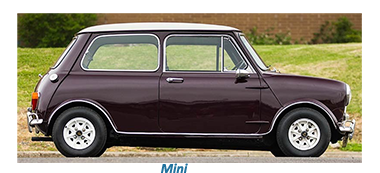 The Mini was the world's first car to combine front-wheel-drive, and a transversely mounted engine in a tiny ten-foot long package providing the most efficient and effective use of road space ever known, anywhere in the World,
The Mini was the world's first car to combine front-wheel-drive, and a transversely mounted engine in a tiny ten-foot long package providing the most efficient and effective use of road space ever known, anywhere in the World,
 Fitted with ten inches (250 mm) diameter road wheels, independent suspension by rubber cone springs, and careful packaging of the cabin, the Mini had superb handling, precise race-car-like steering, and unmatched agility.
Fitted with ten inches (250 mm) diameter road wheels, independent suspension by rubber cone springs, and careful packaging of the cabin, the Mini had superb handling, precise race-car-like steering, and unmatched agility.
Behind the Mini design was Alec Issigonis, who had been handed the task of developing the “compact” for BMC. Issigonis and his team, whose credibility at BMC had been at an all-time high since they had designed the Morris Minor, was handed a challenging brief by the British Motor Corporation.
![]()
As a consequence of the Suez Crisis in 1956, BMC’s forward planners realised that the possibility of a severe and ongoing fuel shortage of fuel shortage was a reality, and moved forward with the project to produce a minimum-size, minimum-price four-seater package — all built around an existing BMC engine.
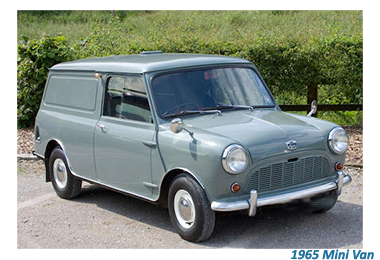 Issigonis and his design team chose the combination of front-wheel-drive and the A-series engine, he then minimised the size of the car by turning the engine sideways and mounted the transmission under the engine.
Issigonis and his design team chose the combination of front-wheel-drive and the A-series engine, he then minimised the size of the car by turning the engine sideways and mounted the transmission under the engine.
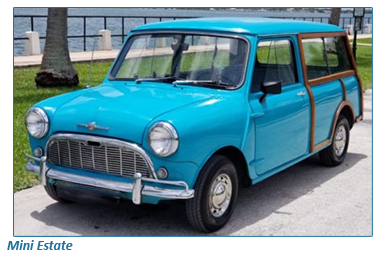 The first Minis were two-door saloons, with the Sevens built at Austin’s plant at Longbridge near Birmingham which the Mini-Minors rolled off the line at Morris’s plant at Cowley.
The first Minis were two-door saloons, with the Sevens built at Austin’s plant at Longbridge near Birmingham which the Mini-Minors rolled off the line at Morris’s plant at Cowley.
The standard specification was an 848cc engine capable of generating just 34 bhp,
Thanks to the success of the saloon, in March 1960 the Countryman model was first produced, having a 4-inch longer wheelbase than the saloon, with an attractively lengthy wood-trimmed estate body, four seats, and extensive luggage accommodation.
Not long after, a Minivan version also appeared, proving to be an ideal vehicle for making low volume deliveries within the UK’s larger towns and cities.
![]()
In October 1967, the Mini progressed to MkII, with a choice of 848cc or 998cc engines, an enlarged rear window, different front grille, larger tail lamps, and enhanced trim.
As before, a four-speed manual gearbox was standard although the AP automatic 'box was available as an optional extra.
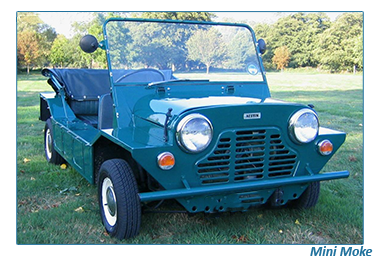 By the summer of 1968, an all-synchromesh manual gearbox was fitted to all models, although the major change came in November 1969.
By the summer of 1968, an all-synchromesh manual gearbox was fitted to all models, although the major change came in November 1969.
For years the Mini ruled the roost in the compact car sector, appealing to every cross-sector of society all over the World.
People who drove Minis came from every social class, from royalty to shop or factory floor workers.
At its peak, production of the Mini kept two factories (Longbridge and Cowley) working flat out, producing 300,000 models every year.
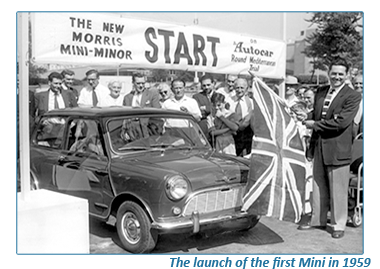 While sales were buoyant, BMC's only problem was that, from the outset, the Mini was priced so tightly that profit margins were wafer-thin.
While sales were buoyant, BMC's only problem was that, from the outset, the Mini was priced so tightly that profit margins were wafer-thin.
By the dawn of the new millennium an impressive five and a half million Minis of all shapes, sizes, badges, and trim levels had been produced through four decades.

 In 1962 an all-metal Countryman model, minus the attractive wooden trim, was introduced for the home market.
In 1962 an all-metal Countryman model, minus the attractive wooden trim, was introduced for the home market. 



